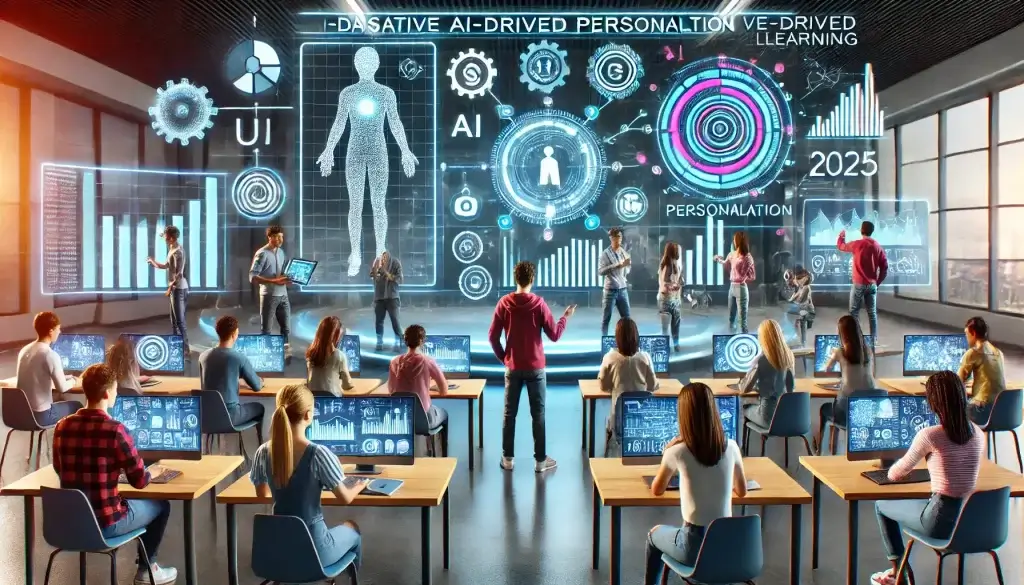It seems that in 2025, personalized learning platforms will actively use AI and ML technologies to customize learning experiences, adapt all available courses, and curate materials accurately tailored to each student’s needs. These technologies will analyze factors like learning style and pace to provide personalized development pathways. The income here is: that personalization is the key to education.
Moreover, these platforms will feature analytics tools that help both students and teachers track progress, pinpoint areas for improvement, and receive actionable recommendations. This will make learning more effective for students and simplify progress tracking and material management for educators.

What are the emerging trends in learning technologies, such as VR/AR?
VR and AR technologies are taking over educational software solutions, making learning more interactive, engaging, and extremely fun. In 2025, this trend will only grow stronger, as we assume at this moment. What makes them stand out? They create environments where students can experience and visualize the material instead of just reading it. This leads to more effective learning, certainly.
For example, VR lets students practice real-life skills in immersive scenarios, while AR enhances the real world with extra information. Whether explaining biological processes or geographical features, these technologies make learning more engaging, boost motivation, and provide an immersive experience. It’s a game-changer in a market filled with online platforms.
How will data privacy and security in education software change in 2025?
Data privacy and security in educational software development areas were big topics last year, and they’ll stay crucial in 2025. What’s coming? We’ll see stronger protections for personal data with new standards and tech. Expect encryption systems and multi-factor authentication to become standard for safeguarding information.
Platforms will also focus on preventing unauthorized access to data, with improved algorithms for monitoring and controlling access. Plus, keeping up with new regulations on personal data protection will be a top priority.
How will education software meet future job market demands in 2025?
It can all be done by focusing on the following key aspects:
- Courses will be designed to teach and practice the essential skills required for modern professions, with a strong emphasis on hands-on experience. It’s a must here. Platforms will frequently update their materials to stay relevant and reflect the fast-paced changes in the workforce.
- Technologies like AI, blockchain, data analytics, and cybersecurity will be integrated into the learning process. These technologies will personalize learning experiences, protect personal data, and ensure students have access to engaging and secure content.
- Educational platforms in 2025 will emphasize hands-on learning, using AR/VR for realistic training and regularly updated materials to match job market needs.
What are the key trends in collaborative learning tools?
Here are the main trends:
- Integration with AI: Enables personalized learning and automatic task adjustments, making AI a must-have integration for education software developers in 2025.
- Interactive Platforms: Platforms now support video conferencing, chats, shared documents, and interactive tasks, tests, and quizzes, which are in high demand.
- Mobility and Accessibility: Mobile apps allow students to learn from anywhere, making it easier to review material during commutes or on the go.
- Gamification: Using game elements to boost motivation and engagement, encouraging healthy competition, and tracking progress.
- Security and Privacy: Enhancing data protection and ensuring safe platforms remain a top priority in 2025.
These tools together create a more engaging, flexible, and secure learning experience.
How will educational technologies and platforms integrate?
In 2025, educational tech and platforms will be even more connected, making learning more personalized and accessible. AI and ML will tailor courses and tasks to fit each student’s needs. Platforms will mix video calls, document sharing, and interactive elements to boost collaboration between everyone involved.
Augmented and virtual reality will make lessons way more realistic, while analytics will track progress and give tips for improvement. Plus, with mobile apps, you’ll be able to study anywhere, whether you’re at home, on the bus, or grabbing a coffee. It’s a convenient option in all possible ways. Learning will be more fun and flexible than ever!
Conclusions
In 2025, learning will be more flexible and interactive than ever. Whether online or offline, the goal is the same. It’s all about absorbing new information as easy and engaging as possible. Personalized learning paths, smart analytics, and real-time collaboration tools will make studying more effective and enjoyable. The result? A learning process that feels less like a chore and more like an exciting journey.
